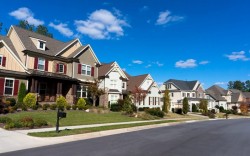You’ve probably heard of gentrification, the term for when a run-down neighborhood is built back up until it attracts residents who are more affluent. Often, this means those who used to live there are unable to afford the area and are forced to move to a cheaper place. Recently, another, related term has been coined: gaytrification. It’s basically the same idea as gentrification, but it’s occurring in gay ghettos and neighborhoods across the country.
The Founding of the Gay Neighborhood
 During the 70s and 80s, most LGBTQ people were in the closet. Discrimination was very real, and many who were out or even hinted at being out were denied rental properties or housing. Many found that they were only really accepted if they lived near other like-minded individuals. Since they weren’t always able to find housing in the more popular parts of cities, they ended up moving into the less desirable neighborhoods. These were the first gay villages.
During the 70s and 80s, most LGBTQ people were in the closet. Discrimination was very real, and many who were out or even hinted at being out were denied rental properties or housing. Many found that they were only really accepted if they lived near other like-minded individuals. Since they weren’t always able to find housing in the more popular parts of cities, they ended up moving into the less desirable neighborhoods. These were the first gay villages.
But while they may have moved into run-down houses and old apartments, it wasn’t always because they lacked money. These modest mortgage payments meant these LGBTQ homeowners were able to put more money towards renovations, transforming areas that were once somewhat abandoned into gorgeous neighborhoods.
It’s Not a Thing of the Past
Today, these older gay neighborhoods such as San Francisco’s Castro District or Chicago’s Boystown are quite pricy. Many people can’t really afford to buy a house there, while those who did purchase a home with prices were lower don’t want to sell. These areas have definitely gentrified, but the process is still going on. When they’re unable to purchase homes in the traditional gay villages, LGBTQ homebuyers may start to congregate in a new area of the city, starting the process of gaytrification all over again.
It’s Not Just Homeowners
It’s definitely a stereotype to say that any LGBTQ homeowner is going to transform their property into a shining house worth millions, but it does certainly happen. Part of the reason these areas grow so quickly is that where the LGBTQ homeowners go, the businesses that cater to them follow. Bars, clubs, and other businesses owned by LGBTQ entrepreneurs help build up these neighborhoods, bringing in more revenue and developers.
While gay neighborhoods haven’t been growing as quickly now that LGBTQ acceptance has become more popular, they do still exist. A gay or lesbian real estate agent can help you find one of these areas if you’re looking to move into one.
